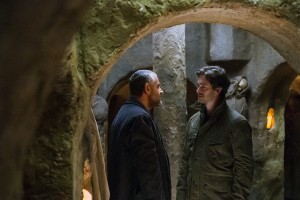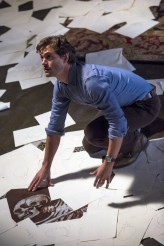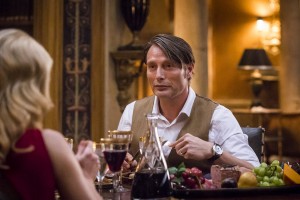At the end of Season 2 of NBC’s HANNIBAL last year, title character and stylist cannibal/serial killer/psychiatrist Hannibal Lecter (Mads Mikkelsen) escaped into the rainy night, leaving our heroes – FBI profiler Will Graham (Hugh Dancy), FBI Behavioral Unit director Jack Crawford (Laurence Fishburne) and FBI agent Alana Bloom (Caroline Dhavernas) – all critically wounded.
Season 3, Thursdays at 10 PM, picks up with Hannibal in Italy, accompanied by his own psychiatrist, Bedelia Du Maurier (Gillian Anderson), while the other protagonists struggle to put themselves and the search for Hannibal back together.
Executive producer Bryan Fuller (creator of PUSHING DAISIES and DEAD LIKE ME, co-creator of WONDERFALLS with Todd Holland, just announced as developer with Michael Green of Starz’s AMERICAN GODS series based on Neil Gaiman’s novel) created HANNIBAL based on the novels by Thomas Harris, which were also the basis for a series of films.
Fuller gets on the phone with Assignment X for an in-depth discussion of HANNIBAL. This is Part 1.
AX: To be clear – Season 3 of HANNIBAL is broken into two chapters?
BRYAN FULLER: Thirteen episodes broken into two chapters, a seven-episode chapter and a six-episode chapter.
AX: And the six-episode chapter is essentially RED DRAGON, which was the first Thomas Harris novel with Hannibal Lecter, originally made as the 1986 feature MANHUNTER and remade as the 2002 film RED DRAGON?
FULLER: Yes, with new dynamics and taking into account where our characters have been over the last two-and-a-half years [of the TV series, which has some changes from the books/films], so certain roles have been shifted, other roles are very much the same, but it is essentially a six-hour RED DRAGON miniseries.
AX: The story seemed like it could use a little more screen time …
FULLER: Yeah. That was one of the fun things about doing it, because the previous two adaptations, they had two hours and we have essentially six.
AX: How much of a time jump there is between the end of Season 2 and beginning of Season 3?
FULLER: We flip around time quite a bit, but the story of Episode One of Season 3 is generally eight months later, even though we have some scenes that take place that very night of the finale, and we have scenes that take place three years before, because it’s nonlinear in many ways, but the main timeline that we are in is eight months after Season 2.
AX: You’ve talked elsewhere about the first part of this season being completely character-driven and non-procedural. In this context, what exactly does “non-procedural” mean?
FULLER: When I say “non-procedural,” I mean “procedural” in the traditional crime television [sense].
AX: So we won’t be seeing any external serial killers who we haven’t already met?
FULLER: Exactly. The serial killer story of the first part of the season is Hannibal Lecter, and finding him, and the various reasons why the characters need to find him is the plot of the first part of the season and everything else comes from character. And that was really liberating, because there was so much to play with between Gillian Anderson coming aboard as a season regular and the dynamic shifted [from] between Hannibal and Will to Hannibal and Bedelia, and Will having his own story as he’s searching for Hannibal, Jack having his own story for searching for Hannibal, and various other characters also on that hunt, including Mason Verger [Joe Anderson takes over the role in Season 3 from Michael Pitt]. So it felt like we didn’t need a serial killer of the week to come in and provide a cool death tableau, and almost as a result of losing that element, the dreamlike quality of the storytelling became enhanced as a stopgap, almost as a bridge to that surrealism of the first two seasons in a way that didn’t require a new victim and serial killer to come in to support it.
AX: Does this make your storytelling easier, that you don’t have the issue of, “Well, I’d really like to explore this in greater depth, but we have to make room for the guest killer of the week”?
FULLER: It does and it doesn’t, because what was interesting in breaking the stories is that the third season, particularly the first half, was understanding just how much of a structure that serial killer of the week provides and going, “Oh, normally we just have a body drop, or some sort of great discovery of an artistic death tableau of sorts.” And we didn’t have that crutch. So it was both liberating and also like, “Oh, that’s what that [guest killer plot] is for” [laughs].
AX: How many different tracks are we following in the first half of the season? That is, Hannibal and Bedelia are on one track, Will is on another track …
FULLER: There are quite a few. There’s Hannibal and Bedelia, there’s Will and Chiyo [Tao Okamoto], there’s Jack and Pazzi [Fortunato Cerlino], there’s Alana and the Vergers, and glimpses of Raul Esparza [as Dr. Frederick Chilton] on his own separate agenda. So there are five interwoven stories in the first seven episodes.
AX: Who’s Pazzi?
FULLER: Potsie is the best friend of Ralph Malph from HAPPY DAYS. No, I’m just kidding. [laughs] There were always jokes in the production [office] because of the name Pazzi [pronounced “Potsie”] and everybody would be like, “Anson Williams?” It was a running source of comedy in the references, but Pazzi is the detective that was played by Giancarlo Giannini in the Ridley Scott movie [HANNIBAL].
AX: HANNIBAL not only has a lot of violence, but it has a lot of very baroque imagery related to the aftermath of the violence. Could you talk about your relationship with Broadcast Standards and Practices? Has there ever been anything where they went, “Okay, we’re a broadcast network and, no, you can’t do this particular thing”?

Fortunato Cerlino as Inspector Pazzi and Hugh Dancy as Will Graham in HANNIBAL | © 2015 Brooke Palmer/NBC
FULLER: Oh, yeah. They are frequently advising us on what they can and cannot do, and since it is a system of mutual respect, I actually respect what they’re trying to do in terms of fulfilling their obligation to Broadcast Standards and Practices as a network. They are subject to a lot of restrictions and I’m sure there is some sort of mathematical tick-box about, too many of one certain thing can result in a fine or what have you. So A), they’ve been incredibly lenient with us, and B) they’ve been incredibly cooperative at the same time, whereas previous experiences on shows – I remember when we were doing WONDERFALLS on Fox, we couldn’t have two women kiss. Absolutely, there was no exception – it was deemed perverse in the eyes of the powers that be at the network, not any of the people that we were immediately working with, but those who paid those people, so there were ridiculous frustrations I’ve had at other networks, where I’m like, “This is odd, at best, that we can’t show these things in context” [laughs].
So to come to NBC, and to be greeted with such willingness to work out solutions in terms of, “Yes, we understand this is the content and this is the story that we’re telling, but in order to get that image on the screen, we have to do these things to it.” And whether that involves color correction providing a shadow to cover a buttock or a sideboob or anything deemed physically inappropriate by the American Standards and Practices Association, they will help us as much as we can navigate those orange cones.
AX: If you were on a cable network, would we see more of Hannibal butchering the bodies?
FULLER: I don’t think we would. I think we are doing as much on NBC as we would be doing on cable.
AX: Speaking of the two women kissing, are you mindful with the Margot Verger character, played by Katharine Isabelle, that it doesn’t appear like she’s been traumatized into being a lesbian – that people don’t equate her trauma with her sexuality?
FULLER: You know, one of the interesting things in the novel HANNIBAL is that there was some of that I read between the lines in the novel, because in the book Margot is traumatized from being repeatedly molested by her brother as a very young girl, and as a result became a steroid-abusing bodybuilder to the point that she was eradicating her femininity, almost at a nuclear level. And that’s how she built up her defenses to keep him off of her and away from her, and there was a lot of [the question of], because of her molestation, did that mean that she became a lesbian? Did that mean that she became a bodybuilder? There are a lot of links to things that I thought, “Well, that’s vaguely homophobic in terms of, ‘A lesbian has to be traumatized into being homosexual,’ as opposed to it being naturally occurring.”
AX: Also, the actress Katharine Isabelle doesn’t look like a steroid-abusing bodybuilder. You’ve cast away from that version of the character.
FULLER: Yes. And not without [reaction]. There were several people online who reached out via Twitter to say that they were incredibly disappointed that that bodybuilding aspect of her was taken away, because they identified with it for one reason or another, and it started to bridge into a transgendered issue, where Margot was eradicating her femininity by various means, did that mean that because of the molestation that she was transgendered? There were a lot of elements at play in the novel that suggested a soup that trauma equals who Margot is. So I wanted to kind of thin that out a bit and present her as a homosexual woman who is navigating very treacherous circumstances, but that trauma did not make her a lesbian. She is a lesbian because she is a lesbian.
AX: Where did you shoot the sequences that are supposed to take place in Italy?
FULLER: We shot exteriors for five days in Florence. It was an interesting experiment. The production value that it provided, to see Bedelia walking in front of gorgeous chapels – you really get to see that, but we only filmed there for five days, got in, got the exteriors and got back to Toronto, where we found or built all of our other Italian sets.
AX: But you have actual Florentine exteriors.
FULLER: Yes, that was nice. And imperative.
AX: Seasons 1 and 2 were midseason. Do you feel the summer run for Season 3 is a good thing or a bad thing?
FULLER: It really was a help for us, just in terms of the production, because there was so much in the production of the first seven episodes, by the time we had been shooting up through Episode Five and I went to go to the editing room in December to lock as many episodes as I could before we went back into production, there wasn’t a single episode complete. Every episode was owing something, it had scenes missing and shots missing, and this is something that we were aware of and kind of ringing the alarm bell, and so by the time we got to January, still no single episode had been locked, because they were all missing something, and that came about as a shift in the style of producing this show that ultimately was to its detriment. So we had to course-correct, and that’s why we got pushed to summer. So I was thrilled that we actually had time to fix the problems. And that was really NBC once again saying, “Well, let’s move it back, let’s get it right.” So that was great.
Related: HANNIBAL’S Bryan Fuller gives the scoop on Season 3 and Season 4 – exclusive – Part 2
Related: Interview with HANNIBAL star Hugh Dancy gives the scoop on Season 2
Related: Interview with HANNIBAL star Mads Mikkelsen – Season 2 Scoop
Follow us on Twitter at ASSIGNMENT X
Like us on Facebook at ASSIGNMENT X
Article Source: Assignment X
Article: HANNIBAL’S Bryan Fuller gives the scoop on Season 3 – exclusive – Part 1
Related Posts:












